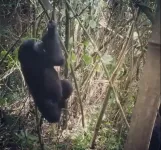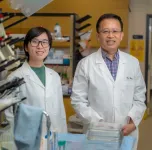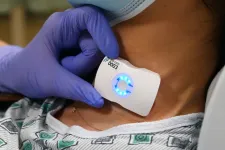(Press-News.org) Scientists have documented plant species for centuries to help us understand and protect the incredible diversity of flora in our world. But according to new research, many have never actually been photographed in their natural habitats – and that’s a problem.
Researchers from UNSW Sydney and the Australian Institute of Botanical Science, part of the Royal Botanic Gardens and Domain Trust, surveyed 33 major online databases of plant photographs to examine the photographic record of Australian plant species. The findings, published in New Phytologist, reveal out of 21,077 native Australian vascular plant species, almost 20 per cent lack a verifiable photograph.
Lead author of the study and UNSW Science PhD student Thomas Mesaglio says Australia is one of the richest areas in the world for native species.
“It was surprising to see how many plant species had just line drawings, illustrations, paintings, or even no media at all,” Mr Mesaglio says.
Dr Hervé Sauquet, co-author of the study and Senior Research Scientist at the Australian Institute of Botanical Science, is based at the National Herbarium of New South Wales.
“All species of plants ultimately rely on specimens in herbarium collections for their identification,” Dr Sauquet says. “Yet, even in this digital age where most herbarium specimens have been scanned and are accessible on the web, photos of live plants in the wild remain in critical need.”
Senior author of the study from UNSW Science Associate Professor Will Cornwell says a lack of detailed photos can have real consequences. Many plant species that are difficult to identify in the wild may go extinct if scientists cannot properly identify them with the help of photos.
“We had assumed every plant species would have simply been photographed by someone, somewhere, throughout history. But it turns out this isn’t the case,” says A/Prof. Cornwell.
“This is where citizen scientists can come in and help us fill this gap with their photos.”
Gaps in the photographic record
Photographs can help botanists and taxonomists who work with plant specimens by preserving characteristics like flower colour that get lost over time in their samples. They can also show additional features, such as the orientation of leaves or bark appearance, and add ecological context.
“Having a comprehensive photographic set helps us to be confident in our identifications,” Mr Mesaglio says. “Particularly when it is practically challenging to collect and preserve the entire plant, photos complement the physical voucher by showing the soil type, the habitat it’s growing in, and other species growing alongside it.”
But it turns out not all plant groups are photographed equally. Just as some animals receive less attention than others, there might also be a bias against less charismatic plants.
The study found the most well–photographed plant groups tend to be shrubs or trees with more noticeable or spectacular features, such as colourful flowers. Banksia, for example, is one of only two Australian plant genera with more than 40 species to have a complete photographic record. Meanwhile, the family with the most significant photo deficit was Poaceae – commonly known as grasses – with 343 unphotographed species.
“We noticed a charisma deficit, so the species that tend to be harder to see are the ones missing out,” Mr Mesaglio says. “They may have innocuous or pale-looking flowers or be smaller and harder to spot grasses, sedges and herbs.”
Geography also affected the photographic record. While most species across the south-eastern states of Australia have comprehensive records, Western Australia had the largest void, with 52 per cent of all unphotographed species found there.
“The primary ‘hotspots’ for unphotographed Australian plants are areas with high plant diversity, but the environments are rugged and often difficult to access, particularly by road,” Mr Mesaglio says. “But it means there’s an exciting opportunity to visit these locations because we might capture something that has never before been photographed.”
Activating citizen scientist snaps
It’s one thing to have comprehensive photographic records for professional scientists to use in identification guides. But when the plant world is under threat from multiple fronts, including habitat clearing and climate change, photos can help engage the public in plant science.
“People can engage with, sympathise with, and get much more excited about plants with photographs, which is vital when our natural environments are more at risk than ever,” Mr Mesaglio says.
“Because digital photography is so accessible now, anyone can also help make a meaningful contribution to science using the camera in their pocket.”
Using a platform like iNaturalist, keen citizen scientists can have their snaps identified by experts and share the data with aggregators like the Atlas of Living Australia and the Global Biodiversity Information Facility to be used in research and conservation.
“Since April last year, we’ve identified nearly 10 per cent of those previously unphotographed species thanks to members of the public uploading their photographs and experts who’ve kindly identified them,” Mr Mesaglio says. “There could be many more in personal collections or behind paywalls just waiting to be shared.”
The researchers recommend a standardised system for scientific plant photography be developed, starting with a requirement in the International Code of Nomenclature for Plants to include at least one field photograph where possible in new species descriptions. They also suggest all new species descriptions be published as Open Access in searchable databases with Creative Commons licensing to maximise their usage.
“We also suspect more photos exist, but they’re hidden away on social media or behind scientific paywalls that aren’t accessible, discoverable, or searchable,” Mr Mesaglio says.
“Of the species with photographs, many have a single photo. We not only want to capture those unrepresented species but also continue building the photographic record for all species.
“Doing so will help us identify, monitor and conserve our native species for generations to come.”
END
Thousands of native plants are unphotographed, and citizen scientists can help fill the gaps
2023-03-14
ELSE PRESS RELEASES FROM THIS DATE:
Study sheds light on concerning new trend in drug advertising: Patient influencers
2023-03-14
Patients-turned-social-media-influencers routinely offer prescription drug advice to their followers and often have close ties with pharmaceutical companies, according to new University of Colorado Boulder research.
But they also tend to have good intentions, the study found.
The study, published this week in the Journal of Medical Internet Research, provides some of the first insights into the burgeoning, loosely regulated world of so-called “patient influencers,” sharing findings from 26 in-depth interviews about why and how they do it.
“The bottom line here is that patient influencers act as a form ...
Checking children’s wellbeing: Before and after COVID-19
2023-03-14
A video game featuring a mystical character named Rumble has helped Griffith University researchers investigate how school kids fared following lockdown disruption.
Dr Jacqueline Allen from Griffith’s School of Criminology and Criminal Justice headed up the team looking at self-reported wellbeing in a sample of primary school-aged children in Queensland, Tasmania and Western Australia.
The team used an innovative video game called Rumble’s Quest, developed wholly within Griffith University, which measures the four key facets of wellbeing, as well as ...
Health: Mediterranean diet associated with decreased risk of dementia
2023-03-14
Consumption of a traditional Mediterranean-type diet – rich in foods such as seafood, fruit, and nuts – is associated with a reduced risk of dementia, reports a study published in BMC Medicine. Individuals with a higher adherence to a Mediterranean diet had up to 23% lower risk for dementia compared with those who had lower adherence to a Mediterranean diet.
Diet may be an important modifiable risk factor for dementia that could be targeted for disease prevention and risk reduction but previous studies exploring the impact of a Mediterranean diet have typically been limited to small sample ...
Dizzy apes provide clues on human need for mind altering experiences
2023-03-14
Great apes spinning behaviours could provide clues about the role of altered states for the origins of the human mind.
Online videos observed great apes spin themselves to deliberately make themselves dizzy.
Researchers say these new findings suggest that the behaviour could be used to understand when humans evolved the desire to seek altered mental states and actively manipulate their mood and perception of reality.
Great apes deliberately spin themselves in order make themselves dizzy, academics at the University ...
Mediterranean diet associated with decreased risk of dementia
2023-03-14
Eating a traditional Mediterranean-type diet – rich in foods such as seafood, fruit, and nuts – may help reduce the risk of dementia by almost a quarter, a new study has revealed.
Experts at Newcastle University found that individuals who ate a Mediterranean-like diet had up to 23% lower risk for dementia than those who did not.
This research, published today in BMC Medicine, is one of the biggest studies of its kind as previous studies have typically been limited to small sample sizes and low numbers ...
Gene essential to making DNA appears to be a good target in minimizing pulmonary hypertension
2023-03-14
AUGUSTA, Ga. (March 14, 2023) – The vascular smooth muscle cells that normally give blood vessel walls strength and flexibility proliferate and become destructive in pulmonary hypertension, a typically rapidly progressing condition that makes it hard to get blood inside our lungs and oxygen to our bodies.
Now scientists have found that inhibiting a gene essential to making DNA so the cells can take on this uncharacteristic growth, can significantly reduce the destructive cell proliferation and disease progression, they report in the European Heart Journal.
The findings point toward a ...
Endometriosis: how to diagnose and manage this complex condition
2023-03-14
Endometriosis is a painful, complex condition affecting about 1 in 10 women of reproductive age, but it is poorly understood. A new clinical review published in CMAJ (Canadian Medical Association Journal) https://www.cmaj.ca/lookup/doi/10.1503/cmaj.220637 provides an overview of the causes, diagnosis and management of endometriosis based on the latest evidence, to help clinicians and patients.
The review is timely, as March is Endometriosis Awareness Month.
Endometriosis, defined as the presence of endometrial-like tissue outside the uterus, is one of the most common gynecologic conditions. It is estimated to affect approximately 1 million women ...
California schools are not immune to political attacks
2023-03-14
A new analysis by researchers at UCLA and UC Riverside shows that even in Blue state California, political attacks on public schools are pervasive and growing, hindering learning and the role schools play in a diverse democracy. Political division and community-level conflict is negatively impacting student interactions, and many California students are experiencing hostility and intolerance in school. Troublingly, the research finds high levels of hostile comments toward LGBTQ students, and racist remarks targeting Latino, and in particular, African American ...
El Camino Health is first in the world to adopt FloPatch advanced ultrasound technology for sepsis management
2023-03-14
El Camino Health is the first health system in the world to adopt FloPatch, an innovative new technology that monitors blood flow in real time. Developed by Flosonics Medical, FloPatch is the world’s first wireless, wearable Doppler ultra-sound system that helps clinicians better manage intravenous (IV) fluid therapy earlier in the sepsis care pathway.
“Timing is crucial when caring for patients with sepsis. Our nurses have seen firsthand how effective FloPatch is in monitoring the effectiveness of treatment in deteriorating patients, especially those with sepsis and low blood pressure,” said Cheryl Reinking, chief nursing officer at El Camino Health. “We ...
Scientists reveal a potential new approach to treating liver cancer
2023-03-13
Scientists reveal a potential new approach to treating liver cancer
Results in cell and mouse studies may have implications for the development of a new class of anticancer drugs
Scientists at the National Institutes of Health and Massachusetts General Hospital in Boston have uncovered a potential new approach against liver cancer that could lead to the development of a new class of anticancer drugs. In a series of experiments in cells and mice, researchers found that an enzyme produced in liver cancer ...




